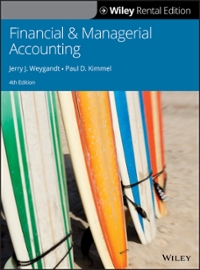Question
Accounting Theory (Economic Consequences of Accounting Policy Choice: Agency Theory) Self-study Questions SQ.1 a) What is the nexus of the contract's view of the firm?
Accounting Theory (Economic Consequences of Accounting Policy Choice: Agency Theory)
Self-study Questions
SQ.1
a) What is the nexus of the contract's view of the firm?
b) How does this view help us understand the behaviours of people in firms?
c) Why, under this view, might the concept of "ownership" be irrelevant?
SQ.2 Rural Press Case (refer to pages 3-4 of this topic guide), part a).This is a difficult case. You are advised to read "comparison of alternative financing strategies 2018" (third item in the readings) before attempting this question.
PART A
TQ.1 This question extends SQ.1 and provides an opportunity to review your understanding of how contracting theory underpins agency theory and positive accounting theory.
a) Describe how accounting information is used in contracts between the shareholders and management.
b) What are the implications of the nexus of contracts view of the firm for accounting policy choice?
TQ.2 RURAL PRESS CASE, part b). You are advised tocomplete SQ.2 before attempting this question
RURAL PRESS CASE
Introduction
AASB 132 requires the classification of financial instruments, such as preference shares, to be determined by the substance of the contract which, in turn, is determined by the terms of the contractual arrangement. For instance, the substance expressed in the terms of the contract, determines whether a preference share issue should be accounted for as equity or as a liability by the issuer. The Rural Press case provides an example in which the accounting treatment led to a change in the substance of the contract. Concerns about how the company's preference share issue would be classified under AASB 132 were the driving force behind changes to the contractual terms of the preference shares.
The Case
Rural Press Limited issued non-redeemable preference shares with a minimum dividend of 1.5 cents per share annum. The preference shares had been classified as equity in accordance with accounting standards prevailing at the time of the 2005 financial statements. The company received the following advice from its auditors:
"The Company has received advice from its Auditors that, as a result of the introduction of the new Accounting Standard AASB 132 (the Australian equivalent of International Accounting Standard IAS 32) dealing with the classification of financial instruments, and the requirement under the constitution of the Company that a dividend of 1.5 cents must be paid on Preferred Shares if there are sufficient profits to do so, it is likely that an amount based on the present value of future dividends of this 1.5 cent minimum payment will be required to be treated by the Company as a financial liability. An expense equivalent to the minimum annual dividend payment would similarly need to be recognised each year." (Notice of Meeting of Preferred Shareholders and Notice of Annual General Meeting 21 October 2005, notice dated 20 September 2005.)
The auditors had advised that the preference share issue must be treated as a liability to the extent of the present value of the minimum 1.5 cents per share dividend in perpetuity. Management did not agree with the auditors' advice but proposed an amendment to the terms of the issue to remove uncertainty about the appropriate accounting classification of the preference shares. The proposal to make the minimum 1.5 cents per share dividend discretionary was accepted by shareholders. Thus the question of how to classify Rural Press Limited's non-redeemable preference shares with a minimum 1.5 cents dividend per annum did not arise in any financial statements to which AASB 132 applied.
Required
Assume the shareholders reject the directors' proposal, such that the minimum 1.5 cents per share dividend still applies to the non-redeemable preference shares.
(SQ.2)
- How should the preference shares be accounted for in accordance with AASB 132? (Hint: the relevant principles to guide this decision are stated in AASB 132, para. 11 definition of a liability, definition of equity; AASB 132, para. 15 requirement to recognise separately the components of an instrument, applying substance over form; AASB 132, para. 28.) You are not required to quantify your answer to this part.
(TQ.2)
b) Given your answer to part a), how should the annual 1.5 cents per share dividend be accounted for? (i.e., as a borrowing cost expense or as a distribution of equity) Explain your answer. (Hint: refer AASB 132, para. 35-36)
Step by Step Solution
There are 3 Steps involved in it
Step: 1

Get Instant Access to Expert-Tailored Solutions
See step-by-step solutions with expert insights and AI powered tools for academic success
Step: 2

Step: 3

Ace Your Homework with AI
Get the answers you need in no time with our AI-driven, step-by-step assistance
Get Started


